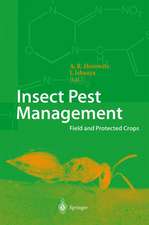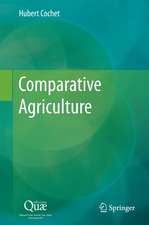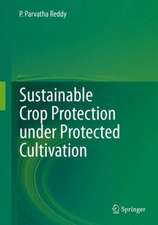Insecticides Design Using Advanced Technologies
Editat de Isaac Ishaaya, Ralf Nauen, A. Rami Horowitzen Limba Engleză Hardback – 3 ian 2007
| Toate formatele și edițiile | Preț | Express |
|---|---|---|
| Paperback (1) | 787.24 lei 38-44 zile | |
| Springer Berlin, Heidelberg – 13 oct 2010 | 787.24 lei 38-44 zile | |
| Hardback (1) | 950.03 lei 6-8 săpt. | |
| Springer Berlin, Heidelberg – 3 ian 2007 | 950.03 lei 6-8 săpt. |
Preț: 950.03 lei
Preț vechi: 1158.57 lei
-18% Nou
Puncte Express: 1425
Preț estimativ în valută:
181.78€ • 190.31$ • 150.42£
181.78€ • 190.31$ • 150.42£
Carte tipărită la comandă
Livrare economică 05-19 aprilie
Preluare comenzi: 021 569.72.76
Specificații
ISBN-13: 9783540469049
ISBN-10: 3540469044
Pagini: 314
Ilustrații: XIV, 314 p.
Dimensiuni: 155 x 235 x 19 mm
Greutate: 0.58 kg
Ediția:2007
Editura: Springer Berlin, Heidelberg
Colecția Springer
Locul publicării:Berlin, Heidelberg, Germany
ISBN-10: 3540469044
Pagini: 314
Ilustrații: XIV, 314 p.
Dimensiuni: 155 x 235 x 19 mm
Greutate: 0.58 kg
Ediția:2007
Editura: Springer Berlin, Heidelberg
Colecția Springer
Locul publicării:Berlin, Heidelberg, Germany
Public țintă
ResearchDescriere
In the past, insecticide development has been guided mostly by chemo-rational and bio-rational design based on understanding of the physiology and ecology of insects and crops. A limitation in each new class of compounds is the evolution of resistance in populations of key pests, which ultimately leads to control failures. This phenomenon and the desire to produce more selective and biorational compounds serve as the driving force to develop advanced technologies for insecticide design. Among the highlights of this book are the use of nanotechnology to increase potency of available insecticides, the use of genetic engineering techniques for controlling insect pests, the development of novel insecticides that bind to unique biochemical receptors, the exploration of natural products as a source for environmentally acceptable insecticides, and the use of insect genomics and cell lines for determining biological and biochemical modes of action of new insecticides.
Cuprins
Nanosuspensions: Emerging Novel Agrochemical Formulations.- Pharmacokinetics: Computational Versus Experimental Approaches to Optimize Insecticidal Chemistry.- High-Throughput Screening and Insect Genomics for New Insecticide Leads.- Transgenic and Paratransgenic Insects in Crop Protection.- Future Insecticides Targeting Genes Involved in the Regulation of Molting and Metamorphosis.- Trypsin Modulating Oostatic Factor for Developing Resistant Crops.- Nicotinic Acetylcholine Receptors as a Continuous Source for Rational Insecticides.- Mitochondrial Electron Transport Complexes as Biochemical Target Sites for Insecticides and Acaricids.- Inhibition of Programmed Cell Death by Baculoviruses: Potential in Pest-Management Strategies.- Plant Natural Products as a Source for Developing Environmentally Acceptable Insecticides.- Essential Oils as Biorational Insecticides–Potency and Mode of Action.- Insect Cell Lines as Tools in Insecticide Mode of Action Research.
Textul de pe ultima copertă
In the past, insecticide development has been guided mostly by chemo-rational and bio-rational design based on understanding of the physiology and ecology of insects and crops. A limitation in each new class of compounds is the evolution of resistance in populations of key pests, which ultimately leads to control failures. This phenomenon and the desire to produce more selective and biorational compounds serve as the driving force to develop advanced technologies for insecticide design. Among the highlights of this book are the use of nanotechnology to increase potency of available insecticides, the use of genetic engineering techniques for controlling insect pests, the development of novel insecticides that bind to unique biochemical receptors, the exploration of natural products as a source for environmentally acceptable insecticides, and the use of insect genomics and cell lines for determining biological and biochemical modes of action of new insecticides.
Caracteristici
The special feature of this book is the focus on the use of nanotechnology, genetic engineering techniques, and the exploration of natural products for the development of new insecticides
Includes supplementary material: sn.pub/extras
Includes supplementary material: sn.pub/extras





























